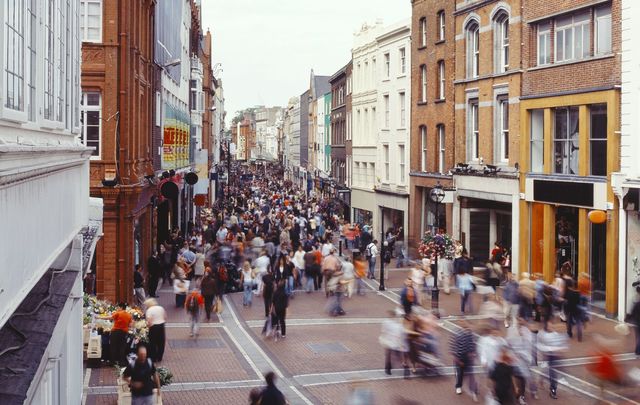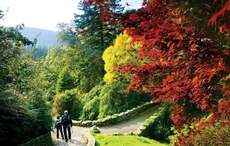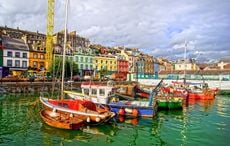Grafton Street, Dublin, pubs, restaurants and shops make it a number one place to stop in Ireland's capital.
A bit like Dublin city itself, Grafton Street presents something of an enigma to visitors. In other major capitals, people gather along grand boulevards to shop, lunch and drink the evening away. In Dublin, we head to Grafton Street, a narrow winding road that’s been at the heart of the city’s social life for more than a century.
Entering from Stephen’s Green in the south, Grafton Street meanders by a series of architecturally rich townhouses, with street-level shops, twisting and turning, narrowing in width to barely twelve yards before sloping down to the broad sweep of College Green and the grand entrance to Trinity.
Read more: Reasons why Dublin is great in winter and spring

Flower stalls on Dublin's Grafton Street. Photo by Karl O'Toole
What should be a pretty little by-road linking two of Dublin’s greatest landmarks, actually eclipses all other streets in Dublin. It’s the place, not just for Dubliners, but for the entire country to shop, lunch or simply hang out.
“Grafton Street’s a wonderland, there’s magic in the air,” goes a popular song that dates from the start of the 20th century. In fact, the street has been Ireland’s shopping mecca since Victorian times. When the British King George V visited Ireland in 1911, he paraded down the street.
The shops have changed of course. Gone are the genteel bespoke clothiers. Now it’s dotted with global fashion brands and the odd fast food outlet. The people, too, look very different. Casual and carefree, they are almost another breed compared to their upright, respectable Victorian-era relatives. But Grafton Street is still a draw. On a busy Saturday afternoon it can be hard work and, sometimes, next to impossible negotiating a path from one end of the street to the other, so dense are the crowds strolling about or gathered around the multiple street entertainers.
Read more: Dublin and surrounding areas tours

A street entertainer on Grafton Street
At night, long after the shops have shuttered, a bevvy of nearby pubs and restaurants, ensure that the street is still thronged with revelers. The magic works all year long, from high summer when tourists swell the crowds, to mid-winter when the Christmas lights come on and the narrow street is full to bursting with shoppers (and boozers!).
There’s a tradition among many Dublin families of heading into Grafton Street on Christmas Eve, less to shop and more to soak up the festive fun, squeeze into over-full cafés and pubs, bump into old friends and remind themselves that for all its claims to be a major European capital, Dublin is, at heart, a small town.
The very narrowness of Grafton Street lends it an intimacy and warmth. Running north to south it gets whatever sunshine is available in Ireland, and the sun playing on the redbrick or terracotta facades of the buildings enhances that feeling of being enclosed in a warm friendly space. The buildings too are narrow, most just six yards wide. They’re highly ornamented, vary greatly in style, but aren’t overly high, mostly four-story at the southern end rising to five-story towards the northern end. This is a people-sized space, a street of elaborate dollhouses for grown-ups.
Read more: Drive back in time through 1970s Dublin with this rare video

Grafton Street is long and narrow which lends it an intimacy at street level
Grafton Street’s origins are humble. An old map of Dublin shows that early in the 17th century a path ran from Trinity College in Dublin to the area now known as Stephen’s Green. It’s believed the path ran along the banks of the since disappeared River Styne, which explains the meandering route of the street today.
Stephen’s Green, back then, was nothing more than a marshy field on the outskirts of Dublin, used for grazing livestock, the odd public execution and the occasional ‘witch’ burning.
Read more: Kerry and the Wild Atlantic Way tours
But the area was on the way up. By mid-century, a park had been created and grand houses built along its perimeter: Stephen’s Green was born. This early gentrification extended to the pathway connecting the new Green to Trinity College.
It was developed, initially for residential housing. It was named Grafton Street, after the Lord Lieutenant of Ireland, Henry Fitzroy, Duke of Grafton and the illegitimate son of Charles II of England (and incidentally, the seven-greats grandfather of the late Princess Diana).

Grafton Street is home to many cafés, shops and nearby pubs
As the years wore on, the street became home to a number of publishers and booksellers. It had a high-class school, Whytes Academy, which was attended by, among others, Thomas Moore, Robert Emmet and the Duke of Wellington.
At the end of the 18th century, a new bridge was built spanning the Liffey and connecting the grand boulevard of Sackville Street (now O’Connell Street) to the south bank of the city and Trinity College. Originally called Carlisle Bridge it too was renamed O’Connell Bridge.
Back then, Sackville Street was the place to shop but Dubliners began to venture south to a new destination. Over the course of the 19th century, Grafton Street was transformed into a Victorian era, high-end shopping area. There were clothing shops for both ladies and gentlemen; jewelers, watch and clock makers, along with food and wine merchants.

Bewley's Oriental Café has long been a favourite of poets, artists and musicians
Read more: Northern Ireland and Game of Thrones tours
Look above the shop names today and the gothic, Art Deco and Jacobean facades beloved by Victorian architects are still intact. Most of the buildings date from the redevelopment during the 19th century. The eclectic mix of styles added to the charm of the street, although the detail now is most likely lost on even its most frequent visitors.
Perhaps to lend the area an exclusive feel, development during the era retained the narrowness of the street, so that today with the crowds and sometimes-garish shop fronts, it requires a determined effort to raise the eyeline above the crowds and shop fronts to admire the intricate detailing of the buildings above.

Weir and Sons on Grafton Street was established in Victorian Times
While Grafton Street has attracted its fair share of chain stores and global brands, some of the original Victorian retailers are still there. In 1849, Hugh Brown and James Thomas opened a drapery shop. Brown Thomas (or BTs), is now one of Ireland’s most exclusive department stores and occupies number 88 on the street. In 1869, Weirs & Sons Jewelers opened at number 5. The business rapidly expanded and it moved to larger premises at number 96 where it still is today.
Shopping is thirsty work. Once established as a shopping area, the roads around Grafton Street quickly filled with pubs and cafés. Probably the most famous Dublin café and certainly its oldest is Bewleys Oriental Café, still there at numbers 97-98, where Whytes Academy had once stood. The Bewley family were Quakers and originally imported tea from Canton in China, before moving into the café trade. They opened shops on Westmoreland Street and South Great Georges Street in Dublin in the late 19th century.
For the new Grafton Street premises, opened in 1927, the family pulled out all the stops. The discovery of Tutankhamen’s Tomb in Egypt a few years previously was used as inspiration for the cafés façade. Harry Clarke, the world-renowned stained glass artist, was commissioned to design a series of windows to light up the rear of the ground floor. These were one of his last works.
Over the years Bewleys was a regular haunt for literary greats such as James Joyce (who mentions the café in Dubliners) and even today, it’s not unusual to see a famous name at one of its tables.
Read more: Mayo and the Cliffs of Moher tours

The Harry Clarke room in Bewley's Grafton Street
The First World War and Ireland’s War of Independence took its toll on the commercial life of Dublin. Retailing too changed. Small, bespoke tailors made way for off-the-peg chain stores.
But Grafton Street quickly adapted. The arrival of the American chain store Woolworths on the street was the first harbinger of this new age of ‘everyday stores for everybody’ and brought to Dublin Hollywood-style cosmetics and daring jazz records.
The street had its own cinema, the Grafton Picture House, which survived up until the 1970s and also served as a late night music venue for artists such as The Dubliners.
The 1970s also saw the first McDonalds open in Ireland, on Grafton Street, of course.
As the 20th century drew to a close, Ireland became increasingly affluent and the already narrow Grafton Street became clogged with traffic. The street was pedestrianized in 1979, giving it a whole new lease of life as street performers, from circus acts to buskers arrived to entertain shoppers.
Read more: Galway and the West tours
Grafton Street's a wonderland...find out more here:Discover the magic of Dublin's Grafton Street. Find out more here:
Posted by Ireland of the Welcomes on Wednesday, January 31, 2018
Today many of the old locally owned retailers have disappeared and many bemoan the prevalence of fast food outlets and mobile phone stores. But Grafton Street has always been a dedicated follower of fashion and, regardless of the changes; nothing yet has managed to destroy the magic in its air.
Have you walked down Grafton Street? What do you love about it? Let us know in the comments section below.
Are you hoping or planning to travel to Ireland this year? Join with other travelers, adventurers and lovers of Ireland in our dedicated travel group, where you can find top tips, great recommendations, and air out any of your concerns and questions.




Comments